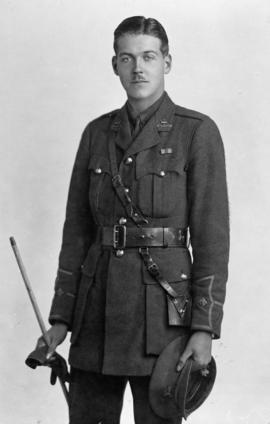Witherby, James Herbert, son of Bernard Oldham Witherby, stockbroker, of Purley, Surrey; b. 31 Jan. 1906; adm. Sept. 1920 (H); left Apr. 1924; lived in Malaya; Malay Defence Force 1941, p.o.w.; lost at sea off Sumatra Feb. 1942.
James Herbert Witherby was born at Acton, Middlesex on the 31st of January 1906 the only son of Bernard Oldham Witherby, a stockjobber and a Member of the London Stock Exchange, and Isabel Witherby of 64, Ramillies Road, Acton Green in London. He was christened at St Mary’s Church, Stamford Brook on the 20th of May 1906. He was educated at Westminster School where he was up Homeboarders from September 1920 to April 1924. He was a member of the Colts Football XI in 1920 and of the 1st Football XI from 1921 to 1924 where he played at centre half. The Elizabethan wrote of his 1922/23 season: - “Very clever dribbler and a splendid feeder of his forwards. Wants to show more pace in getting back to his own goal, when the opposing centre forward has beaten him. A poor shot at goal, who could improve with practice. Has been a most successful pivot to the whole side.” They wrote of his 1923/24 season: - “The only first class performer on the side. Has beautiful control of the ball, and has carved out many a glorious opening for his forwards – the hallmark of a good centre half. Is a little apt to give his opposition centre forward too much rope. His inability to get back quickly after taking a prominent part in an attack being largely responsible for this. Given opportunities, should go far in the game.” He was awarded his School Colours for Football in 1924.
He moved to Malaya as a rubber planter in 1927 where he worked as assistant manager at the Langkon Estate, a job he left in October 1929 to accept the position of assistant manager at the Menrtri Estate, Pahang, where he was later appointed as manager of the plantation. He played cricket for Malacca and for Jasin Cricket Club and was a member of the Malacca Tennis Club. He was also a member of the Jasin Rugby XV. He was married at St George’s Church, Penang to Joan (nee Wilkinson later Hale) on the 18th of October 1938.
He enlisted in the 4th (Pahang) Battalion, Federated Malay States Volunteer Force where he rose to the rank of Company Sergeant Major. On the fall of Singapore to the Japanese on the 15th of February 1942, efforts were made to evacuate as many people as possible from the colony. By late February, James Witherby was one of thousands of evacuees gathered at Emmahaven Padang in the hope of boarding a ship. He managed to find a place on board the 1,693 ton merchant ship SS Ban Ho Guan, under the command of Captain Van der Berg, which departed Emmahaven at around 5am on the morning of the 28th of February 1942 with 227 passengers and 8 to 10 crew on board. She was bound for Tjilatjap and then on to Freemantle in Australia. James Witherby was one of five members of the Federated Malay States Volunteer Force who were on board. During the early part of the journey the ship received a message from the Dutch naval authorities at Tjilatjap that the town was under Japanese air attack and that they should head for the nearest land instead of going there.
Several hours after her departure and having changed from her original course, the SS Ban Ho Guan was sailing to the south of Bali when she was sunk at 5.45pm by the Japanese submarine I-4, under the command of Lieutenant Haijam Nakagawa. There were no survivors, although there were unconfirmed reports that Captain Van der Berg had been captured and taken to Japan
The lack of survivors was very unusual at that time but Haijam Nakagawa gathered a reputation during the rest of the war for killing the survivors of his sinkings. He was tried for war crimes at the end of the war and was convicted in January 1947. He was sentenced to eight year in prison but served only four.
He is commemorated on the Singapore Memorial Column 390.
